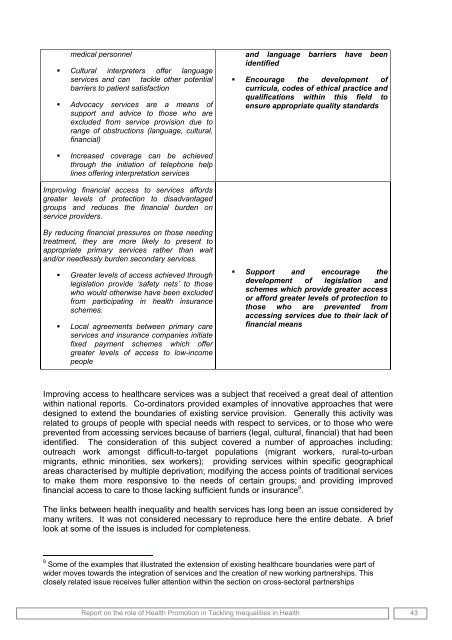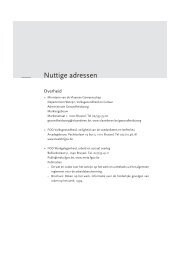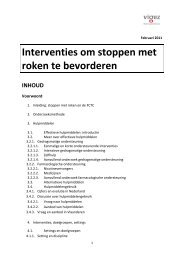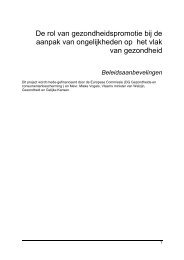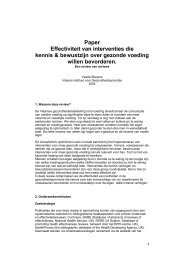Annex 1: Inventory of indicators from surveys and registries
Annex 1: Inventory of indicators from surveys and registries
Annex 1: Inventory of indicators from surveys and registries
You also want an ePaper? Increase the reach of your titles
YUMPU automatically turns print PDFs into web optimized ePapers that Google loves.
medical personnel<br />
� Cultural interpreters <strong>of</strong>fer language<br />
services <strong>and</strong> can tackle other potential<br />
barriers to patient satisfaction<br />
� Advocacy services are a means <strong>of</strong><br />
support <strong>and</strong> advice to those who are<br />
excluded <strong>from</strong> service provision due to<br />
range <strong>of</strong> obstructions (language, cultural,<br />
financial)<br />
� Increased coverage can be achieved<br />
through the initiation <strong>of</strong> telephone help<br />
lines <strong>of</strong>fering interpretation services<br />
Improving financial access to services affords<br />
greater levels <strong>of</strong> protection to disadvantaged<br />
groups <strong>and</strong> reduces the financial burden on<br />
service providers.<br />
By reducing financial pressures on those needing<br />
treatment, they are more likely to present to<br />
appropriate primary services rather than wait<br />
<strong>and</strong>/or needlessly burden secondary services.<br />
� Greater levels <strong>of</strong> access achieved through<br />
legislation provide ‘safety nets’ to those<br />
who would otherwise have been excluded<br />
<strong>from</strong> participating in health insurance<br />
schemes.<br />
� Local agreements between primary care<br />
services <strong>and</strong> insurance companies initiate<br />
fixed payment schemes which <strong>of</strong>fer<br />
greater levels <strong>of</strong> access to low-income<br />
people<br />
Report on the role <strong>of</strong> Health Promotion in Tackling Inequalities in Health<br />
<strong>and</strong> language barriers have been<br />
identified<br />
� Encourage the development <strong>of</strong><br />
curricula, codes <strong>of</strong> ethical practice <strong>and</strong><br />
qualifications within this field to<br />
ensure appropriate quality st<strong>and</strong>ards<br />
� Support <strong>and</strong> encourage the<br />
development <strong>of</strong> legislation <strong>and</strong><br />
schemes which provide greater access<br />
or afford greater levels <strong>of</strong> protection to<br />
those who are prevented <strong>from</strong><br />
accessing services due to their lack <strong>of</strong><br />
financial means<br />
Improving access to healthcare services was a subject that received a great deal <strong>of</strong> attention<br />
within national reports. Co-ordinators provided examples <strong>of</strong> innovative approaches that were<br />
designed to extend the boundaries <strong>of</strong> existing service provision. Generally this activity was<br />
related to groups <strong>of</strong> people with special needs with respect to services, or to those who were<br />
prevented <strong>from</strong> accessing services because <strong>of</strong> barriers (legal, cultural, financial) that had been<br />
identified. The consideration <strong>of</strong> this subject covered a number <strong>of</strong> approaches including:<br />
outreach work amongst difficult-to-target populations (migrant workers, rural-to-urban<br />
migrants, ethnic minorities, sex workers); providing services within specific geographical<br />
areas characterised by multiple deprivation; modifying the access points <strong>of</strong> traditional services<br />
to make them more responsive to the needs <strong>of</strong> certain groups; <strong>and</strong> providing improved<br />
financial access to care to those lacking sufficient funds or insurance 9 .<br />
The links between health inequality <strong>and</strong> health services has long been an issue considered by<br />
many writers. It was not considered necessary to reproduce here the entire debate. A brief<br />
look at some <strong>of</strong> the issues is included for completeness.<br />
9 Some <strong>of</strong> the examples that illustrated the extension <strong>of</strong> existing healthcare boundaries were part <strong>of</strong><br />
wider moves towards the integration <strong>of</strong> services <strong>and</strong> the creation <strong>of</strong> new working partnerships. This<br />
closely related issue receives fuller attention within the section on cross-sectoral partnerships<br />
43


